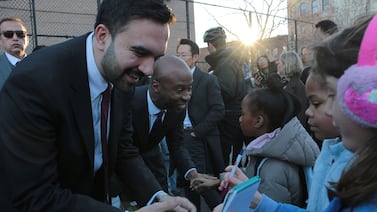New York City’s education department will “permanently close” the command center that collects reports of positive COVID cases among students and school staff, according to an email sent to principals on Tuesday.
Along with the Dec. 23 closure of the “Situation Room,” families will no longer receive the automatically generated email notifications about cases in their school communities, and schools will no longer have to send letters about positive cases, said the note in the weekly digest to principals.
“You will no longer be required to inform members of your school community of individual COVID-19 cases by letter,” the email said.
The change comes as COVID cases are on the rise, with a masked Mayor Eric Adams on Tuesday holding his first COVID briefing in months. Flanked by the city’s top health officials, Adams warned of the “extremely challenging” moment the city is facing with the uptick of COVID, flu, and RSV.
Closing the Situation Room might not have much of a practical effect on how schools respond to COVID cases. Not having to send the letters is a “reprieve,” said one middle school administrator.
Schools should continue to report coronavirus cases to a “return to school” online form, and parents and staffers will still be able to see their schools’ positive cases by visiting the city’s daily COVID case map, according to the note. And officials said that the operations would continue but as part of the education department’s “emergency operations center.”
Schools saw 1,956 cases reported among students and staffers on Monday, the highest single-day total this school year, according to cumulative data from Parents for Responsive Equitable Safe Schools. Schools citywide have seen 54,596 cases this school year, nearly triple the number at the same time last year when there were 19,667 reported cases.
As cases have increased, attendance has declined. About 15% of kids missed school on Monday, according to city data.
The city initially launched the Situation Room as a rapid response team to help schools with contact tracing and making classroom or school closure decisions when campuses reopened in the fall of 2020. The inter-agency collaboration between the education and health departments was riddled with problems, including delayed response times and confusing guidance.
But as schools no longer do contact tracing nor close classrooms in response to positive cases, the Situation Room’s role has become less critical.
“The safety and well-being of our students, staff and school communities has been and continues to be, our top priority,” education department spokesperson Jenna Lyle said in a statement. “Principals and school leaders will now be supported by the NYC Public Schools’ 24/7/365 Emergency Operations Center and continue to receive support and guidance from their borough health director for all COVID related matters.”
Students and staff must isolate for five days after testing positive for COVID. They can return to school on the sixth day if they have no symptoms, but must remain masked until Day 10.
Education department officials are recommending everyone wear face coverings indoors as the “tripledemic” of COVID, flu, and RSV have hit the city’s schools.
Amy Zimmer is the bureau chief for Chalkbeat New York. Contact Amy at azimmer@chalkbeat.org.






